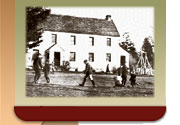| |
Introducing the Cariboo Gold Rush
This lesson provides a general historical overview of the locales, main events, and major participants involved in the Cariboo Gold Rush. Various socio-political, economic, and technological issues related to the Gold Rush are also introduced. An in-depth exploration of some of these issues is pursued in other lessons for which this lesson forms the prerequisite.
Prescribed Learning Outcomes
This lesson enables students to achieve the following provincially prescribed learning outcomes for B.C. in whole or in part.
Grade 10 Social Studies
Society and Culture: Canada from 1815 to 1914
It is expected that students will:
- identify the influence of immigration on, and the contributions of immigrants to, the development of Canada
Environment: Canada from 1815 to 1914
It is expected that students will:
- construct, interpret, and use graphs, tables, grids, scales, legends, contours, and various types of maps
- analyse how geography influenced the economic, historical, and cultural development of western Canada
Grade 10 English Language Arts
Comprehend and Respond (Comprehension)
It is expected that students will:
- make generalizations, supported by specific details and examples, about the key concepts, characters, and themes of written, oral, and visual works
- interpret details and draw conclusions about the information presented in a variety of illustrations, maps, charts, graphs, and other graphic forms
Organization & Scheduling
Suggested time: 2-3 hours
Materials & Resources
- student resource: The Cariboo Gold Rush Adventure Game: Map of the World; Map of Routes to British
Columbia, 1862;
- student resource: Map of the Cariboo, 1862-65;
- student resource: Map of the Cariboo Wagon Road,
www.tbc.gov.bc.ca/culture/schoolnet/cariboo/mapindex/index.html
- teacher resource: Introduction to the Cariboo Gold Rush
Suggested Procedure
- Use a timeline to introduce students to the general chronology of the mid-nineteenth century to place the Cariboo Gold Rush in the larger context of international events such as, for example, the California Gold Rush of 148-49, the Civil War in the United States, the extension of the British Empire (see "The World in the Decade of the 1860s" in The Cariboo Gold Rush Adventure Game). You may wish to make and distribute copies of the Map of the World from The Cariboo Gold Rush Adventure Game to anchor your introduction. Extend this introduction by tracing some of the main events of the Cariboo Gold Rush, briefly presenting some of its main actors (e.g., Amor de Cosmos, Sir James Douglas), and suggesting some of the impacts on the development of British Columbia. The teacher resource Introduction to the Cariboo Gold Rush may assist in this introduction.
- Ask students to access the following in The Cariboo Gold Rush Adventure Game or make and distribute copies:
- the Map of Routes to British Columbia, 1862
- Map of the Cariboo, 1862-65
- Map of the Cariboo Wagon Road.
When the students have familiarized themselves with the main travel routes, have them identify the modes of transportation by which people could travel to the colony (e.g. overland, ocean travel, steamboat and stagecoach within the colony). Ask them to suggest ways in which transportation technology can influence settlement patterns and bring about social and economic change.
- Have students work in pairs or in groups with The Cariboo Gold Rush Adventure Game to identify principal groups involved in or affected by the Cariboo Gold Rush (e.g., the miners, government officials, Aboriginal peoples, women, Chinese merchants). Ask them how the various groups participated in the economic opportunities the gold rush presented.
- Divide students into groups to select representative items for a Cariboo Gold Rush time capsule that would capture the event's various aspects-social, technological, economic, and personal. Use the exercise to promote an awareness of the nature of historical evidence (e.g., physical, written and visual documents, archaeological remains). Instruct students to select only five crucial items for the time capsule to represent this event and to be prepared to justify their choices. The list might include such items as:
- a steamer ticket for transportation to the Cariboo
- a travel document issued by a foreign country
- a miner's licence
- a gold pan
- a photograph of an individual or group
- an item of clothing
- a receipt for goods purchased
- a personal diary or letter
- a newspaper clipping
- a photograph of a building or a townscape
- a map of a specific location
The groups should report on and explain their choices to the entire class. Have the class as a whole vote to select the time capsule that in their view best represents this event.
Possible Assessment
- Evaluate the group presentations on the choice of items for the Cariboo Gold Rush time capsule. Look for evidence that students have successfully understood that the event involved a number of personal, social, and technological elements. The items chosen should reflect some of the following:
- personal experience: expatriation, travel
- societal change: population growth, immigration, impact on and role of Aboriginal peoples
- transportation technology: steamboat and/or stagecoach travel
- mining technology: gold pan, sluice box
- governmental supervision: licensing, provision of law and order
- secondary economic activities: retail trade, provision of transportation
- immigration: growth of towns and facilities
- infrastructure changes: road building, construction of houses and public buildings
- communications: newspapers established
Extensions
- Classes in areas with easy access to the actual Cariboo Gold Rush sites would ideally arrange to visit heritage locations and museums. Preparation prior to the excursion is necessary and debriefing should follow it. Alternatively, have students access the Gold Rush Town of Yale site [http://www.tbc.gov.bc.ca/culture/schoolnet/yale]. Divide them into pairs or small groups to explore an aspect of the town's life in-depth: its history from Aboriginal village to boomtown, its inhabitants, homes and public buildings, layout, and business activities. Ask students to present their findings to the entire class
- Have students pursue in greater depth the participation either of the Aboriginal peoples, women, or Chinese immigrants in the Cariboo Gold Rush, using conventional and/or online sources to focus on an individual or on the group as a whole. The findings can be reported to the entire class.
- Ask students to work alone or in teams to discover in conventional and/or online sources how the gold rushes in California (1848-49), Australia (1851), and the Klondike (1898) resembled or contrasted with British Columbia's Cariboo Gold Rush, with respect to one or more selected aspects--economic development, political consequences, social change..
Introduction to the Cariboo Gold Rush - teacher resource
|



